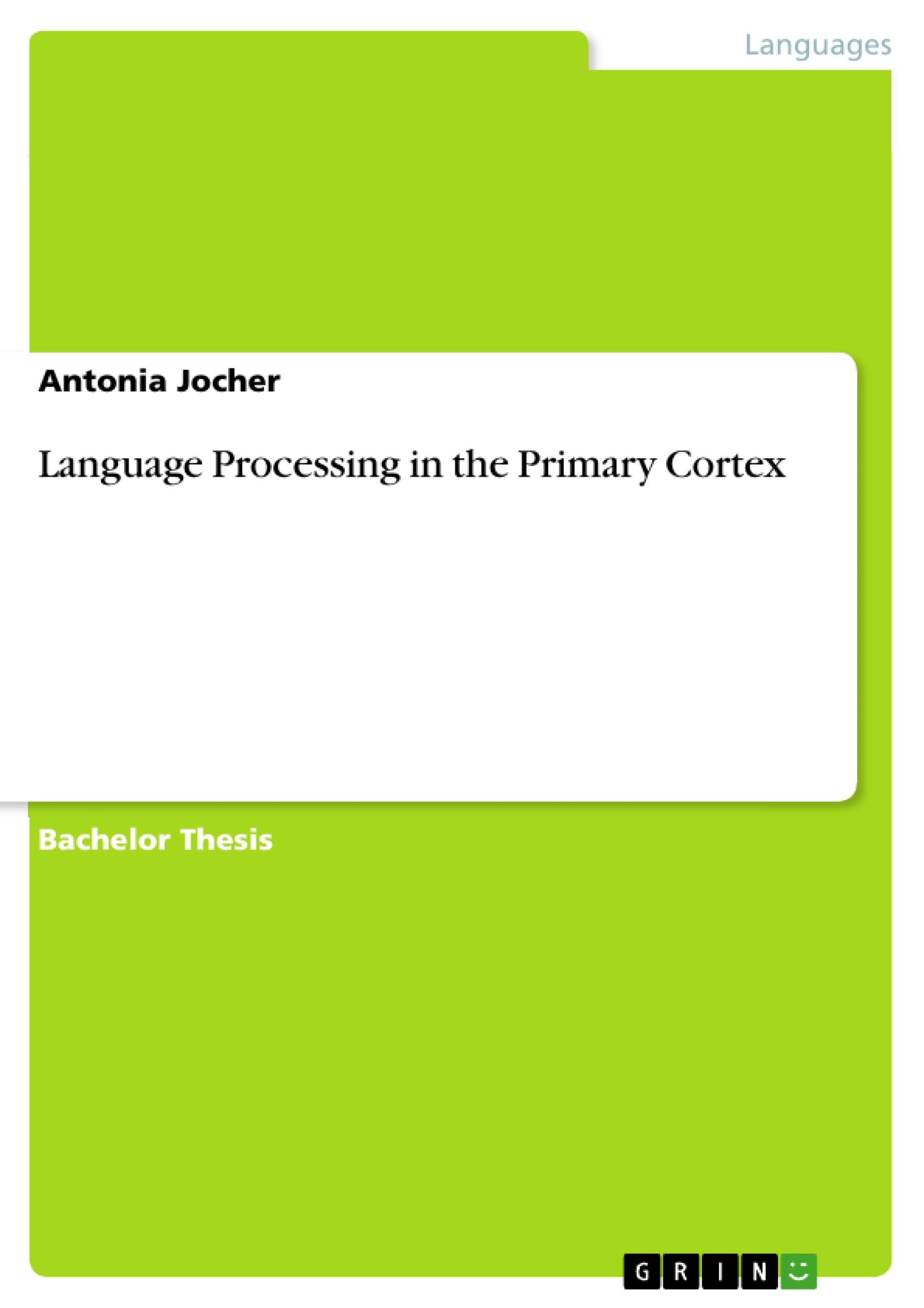
Language Processing in the Primary Cortex
Bachelorarbeit, 2016
38 Seiten, Note: 2,3
Leseprobe
Inhaltsverzeichnis (Table of Contents)
- 1. Introduction
- 2. Terminology: Language and Language Processing
- 3. Basic Ideas about Brain and Language: A Historical Review.
- 3.1 Antiquity
- 3.2 Middle ages to 1800
- 3.3 Localism of Gall and Broca
- 3.4 Associationism: Wernicke and Lichtheim
- 3.5 Jackson's Evolutionary Model.
- 3.6 The Concept of Holism
- 3.7 Dynamic Localization of Function.
- 3.8 Geschwind's Concept of Connectionism........
- 4. Brain Anatomy
- 4.1 The Meninges
- 4.2 The Brain stem
- 4.3 The Cerebellum.
- 4.4 The Diencephalon
- 4.5 The Cerebrum
- 4.6 The Cerebral Cortex
- 4.7 Gray and White Matter
- 4.8 The Ventricular System ..
- 4.9 Blood Supply.......
- 5. The Core Cortical Language Areas
- 5.1 Language Lateralization
- 5.2 Broca's Area
- 5.3 Wernicke's Area
- 5.4 Angular and Supramarginal Gyrus
- 6. Linguistic and Neural Mechanism of Language Components .......
- 6.1 The Dual Loop Model.
- 6.2 Linguistic Organization of Speech Production
- 6.3 Linguistic Organization of Speech Comprehension
- 6.4 Linguistic Organization of Written Language Comprehension.
- 6.5 Neuroanatomical Organization of Speech Production
- 6.6 Neuroanatomical Organization of Speech Comprehension
- 6.7 The Neuroanatomical Organization of Written Language Comprehension
- 7. Aphasia: Syndromes and Symptoms....
- 7.1 Broca's Aphasia ...
- 7.2 Wernicke's Aphasia.
- 7.3 Conduction Aphasia
- 8. Methods of Investigation
- 8.1 Cerebral Angiography
- 8.2 Neural Stimulation
- 8.3 Wada Test
- 8.4 Structural Neural Imaging: CT and MRI...
- 8.5 Functional Neural Imaging: EEG, ERP, MEG, PET, rCBF, and fMRI.
- 9. Conclusion...
Zielsetzung und Themenschwerpunkte (Objectives and Key Themes)
This thesis aims to explore the cortical brain areas involved in language processing and their structural organization. It provides a historical overview of how language-brain relations were understood in the past, followed by a detailed anatomical description of the whole brain to better comprehend neural language mechanisms. Additionally, the thesis examines major language disorder types that have contributed to the localization of language functions. The work concludes with an outline of the most important investigative methods used for detailed scientific language-related research.
- The neuroanatomical organization of language processing in the brain.
- A historical overview of the evolution of understanding language-brain relations.
- Major language disorders and their contributions to understanding language localization.
- Methods of investigation for studying language-brain interactions.
Zusammenfassung der Kapitel (Chapter Summaries)
The first chapter provides an introduction to the study of language from a neurocognitive perspective. It highlights the importance of understanding language for human behavior and emphasizes the unique nature of human language compared to animal communication systems. The second chapter delves into the definition and terminology surrounding language and language processing. Chapter three presents a historical review of key theories and concepts related to the brain and language, from antiquity to the modern era. The chapter examines different perspectives on language localization and its evolution, including the work of Gall, Broca, Wernicke, Lichtheim, and Jackson.
Chapter four provides a detailed anatomical description of the brain, including the meninges, brain stem, cerebellum, diencephalon, cerebrum, cerebral cortex, gray and white matter, ventricular system, and blood supply. Chapter five focuses on the core cortical language areas, exploring language lateralization and the functions of Broca's area, Wernicke's area, and the angular and supramarginal gyrus. Chapter six examines the linguistic and neural mechanisms underlying various language components, including speech production, speech comprehension, and written language comprehension. The chapter also delves into the neuroanatomical organization of these processes.
Chapter seven explores aphasia, a language disorder, by outlining its various syndromes and symptoms. This chapter focuses on Broca's aphasia, Wernicke's aphasia, and conduction aphasia. Lastly, chapter eight presents an overview of the most important methods of investigation used in language research, such as cerebral angiography, neural stimulation, the Wada test, structural imaging techniques (CT and MRI), and functional imaging techniques (EEG, ERP, MEG, PET, rCBF, and fMRI).
Schlüsselwörter (Keywords)
This thesis focuses on the neurocognitive aspects of language processing, examining the brain regions involved, historical perspectives on language localization, major language disorders, and the methods used to investigate language-brain relationships. Key concepts include language lateralization, Broca's area, Wernicke's area, aphasia, and various neuroimaging techniques.
Details
- Titel
- Language Processing in the Primary Cortex
- Hochschule
- Universität Augsburg
- Note
- 2,3
- Autor
- Antonia Jocher (Autor:in)
- Erscheinungsjahr
- 2016
- Seiten
- 38
- Katalognummer
- V365511
- ISBN (eBook)
- 9783668448476
- ISBN (Buch)
- 9783668448483
- Dateigröße
- 1156 KB
- Sprache
- Englisch
- Schlagworte
- language processing primary cortex
- Produktsicherheit
- GRIN Publishing GmbH
- Preis (Ebook)
- US$ 16,99
- Preis (Book)
- US$ 18,99
- Arbeit zitieren
- Antonia Jocher (Autor:in), 2016, Language Processing in the Primary Cortex, München, Page::Imprint:: GRINVerlagOHG, https://www.diplomarbeiten24.de/document/365511
- Autor werden
- Ihre Optionen
- Vertriebskanäle
- Premium Services
- Autorenprofil
- Textarten und Formate
- Services für Verlage, Hochschulen, Unternehmen

- © GRIN Publishing GmbH.
- Alle Inhalte urheberrechtlich geschützt. Kopieren und verbreiten untersagt.
- info@grin.com
- AGB
- Open Publishing
Der GRIN Verlag hat sich seit 1998 auf die Veröffentlichung akademischer eBooks und Bücher spezialisiert. Der GRIN Verlag steht damit als erstes Unternehmen für User Generated Quality Content. Die Verlagsseiten GRIN.com, Hausarbeiten.de und Diplomarbeiten24 bieten für Hochschullehrer, Absolventen und Studenten die ideale Plattform, wissenschaftliche Texte wie Hausarbeiten, Referate, Bachelorarbeiten, Masterarbeiten, Diplomarbeiten, Dissertationen und wissenschaftliche Aufsätze einem breiten Publikum zu präsentieren.
Kostenfreie Veröffentlichung: Hausarbeit, Bachelorarbeit, Diplomarbeit, Dissertation, Masterarbeit, Interpretation oder Referat jetzt veröffentlichen!
- GRIN Verlag GmbH
-
- Nymphenburger Str. 86
- 80636
- Munich, Deutschland
- +49 89-550559-0
- +49 89-550559-10
- info@grin.com
-









